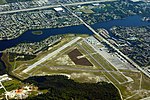Palm Springs is a village in Palm Beach County, Florida, United States, situated approximately 61 mi (98 km) north of Miami. The village's name was likely derived from the resort city of Palm Springs, California. Located in the east-central part of the county, Palm Springs is situated north of Atlantis, east of Greenacres, west of Lake Clarke Shores and Lake Worth Beach, and southwest of West Palm Beach. The 2010 United States census recorded the village's population at 18,928, which increased to 26,890 in the 2020 census. Palm Springs is also located within the Miami metropolitan area, which had a population of approximately 6,138,333 people as of 2020.William A. Boutwell operated a dairy farm on 5 acres (2.0 ha) of land in modern-day Palm Springs beginning in 1927, which expanded to about 700 acres (280 ha) prior to his retirement in 1956. One year later, the Florida Legislature approved a charter establishing the village of Palm Springs as Palm Beach County's 30th municipality on May 31, 1957. At the time of incorporation, the village consisted only of farmland, a dairy barn, and no permanent residents. Within two years, around 800 homes had been built, and four schools were constructed in or near Palm Springs between 1959 and 1970. The first village hall was erected in 1960.
Palm Springs has been expanding through annexation since 1998, more than doubling the village's land area and population within a few decades. Also around that time, the village government began planning for a new municipal complex, which opened in the mid-2000s. By 2010, Palm Springs became the first municipality in Palm Beach County in which a majority of its residents are of Hispanic or Latino ancestry. The village is also the home of the Fulton-Holland Educational Services Center, the headquarters of the School District of Palm Beach County.



